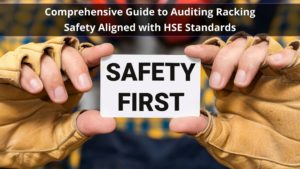
The SEMA Racking Code of Practice forms the basis for all of the advice SEMA gives, but what is it exactly?
The SEMA Racking Code of Practice is not one article, or one document, but a series of documents which tackle different elements of storage equipment safety. All of them are available to download from the SEMA website for a range of different prices.
The advice issued by the SEMA Racking is consistent with HSE law. If it wasn’t, then there would be no point in following it. HSE’s HSG76 outlines some general principles about warehouse safety and it alludes to relevant laws, but the SEMA Racking Code of Practice is intended as a guide to racking safety specifically — with each separate document dedicated to a specific element of warehouse safety.
Combining SEMA’s knowledge of racking systems with a solid interpretation of the law, the SEMA Racking Code’s of Practice is as close as you can get to storage equipment safety gospel in the UK. In fact, during the SEMA Safety Seminar in June 2015, SEMA revealed that they had been talking with HSE about turning some of their SEMA Racking Code of Practice into law. As of May 2017, this hasn’t happened. However, the fact that HSE and SEMA’s relationship is so close shows how important the SEMA Racking Code of Practice is to storage equipment safety.
What Does the SEMA Racking Code of Practice Say?
It’s hard to summarise the advice, as it’s spread across several different documents and covers many different elements of racking safety, but there are technical bulletins which address some of the more common (and most important) elements of racking safety.
One technical bulletin, for example, addresses the use of rack protectors. Technical Bulletin No. 3, which acts as an update/clarification of the SEMA Racking Codes of Practice, claims that rack protectors are often misused because clause 639 of HSE’s HSG76 gets misinterpreted. The clause states that “where racking is likely to be struck by lift trucks and other vehicles, it should be protected.”
Most end users of racking systems interpret this clause to mean that physical rack protectors are enough to protect a racking system and that vehicles bumping into the rack protectors is just part of the day-to-day workings of a warehouse. In short, many see rack protectors’ job as something which is designed to withstand regular bumps and scrapes from trucks and other machinery.
This is wrong. Rack protectors should be seen as the last resort rather than the only form of rack protection. Rack protection should be preventative and the physical protectors are only there in case they are absolutely needed. Like a motorcycle helmet, rack protectors are not there so you can act recklessly. They are a form of protection intended to save you from the worst possible outcome of an accident.
From this one technical bulletin, we can see how the SEMA Racking Code of Practice works. It is ancillary to — and works alongside — HSE HSG76, the law, and common sense. The SEMA Racking Code of Practice is vital for all users of storage equipment to understand, and users can download every part they need from the SEMA website.
The SEMA Racking Code of Practice & Racking Inspection Frequency
Some of the most important advice issued by both SEMA and HSE is with regards to racking inspections and racking inspection frequency. This is an integral part of the SEMA Racking Code of Practice, HSE HSG76, and storage equipment safety in general.
It’s recommended that all storage systems receive a racking inspections from a SEMA approved inspector at least once a year and a more regular inspection from competent staff. In order to make sure your staff are competent enough to perform regular racking inspections, we would recommend racking inspection training from a SEMA approved racking inspector.
SEMA Approved Racking Inspectors have spent years studying the SEMA Racking Code of Practice as well as understanding all of its updates. So, for a rack safety inspection or rack safety inspection training from a SEMA approved racking inspector and expert on the SEMA Racking Code of Practice, contact Storage Equipment Experts today!





